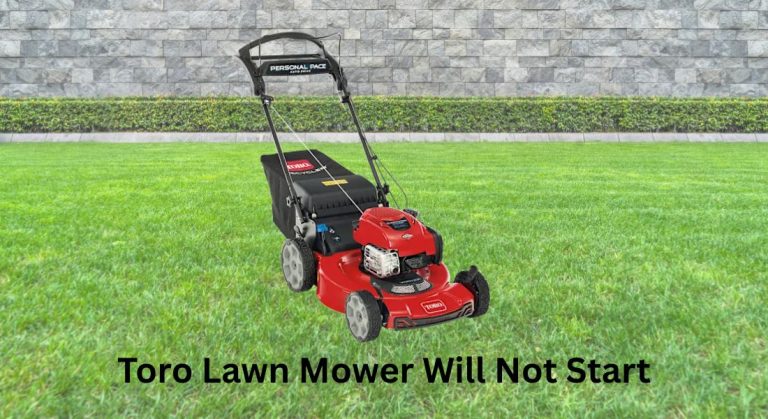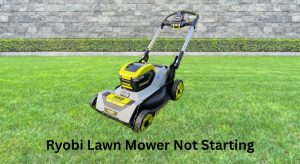It’s mowing day and your Toro lawn mower will not start. Frustrating, right? The quick fix that works in many cases: check the fuel. Old gas is the number one culprit. Drain the tank and carburetor bowl, add fresh gasoline (E10 or less), and try priming and pulling again. Many Toro mowers roar back to life after a simple fuel refresh.
In this comprehensive guide, you’ll learn every likely cause and proven solution to fix a Toro mower that won’t start—whether it’s a push mower, Recycler, Personal Pace, or a self-propelled model with a Briggs & Stratton, Honda, or Toro engine. We’ll cover fuel, spark, air, safety switches, battery (for electric-start), carburetor cleaning, and more. By the end, you’ll know exactly how to diagnose and repair your mower safely and efficiently.
Common Causes of a Toro Lawn Mower Not Starting
- Stale/contaminated fuel or incorrect fuel type
- Clogged carburetor or dirty main jet
- Flooded engine from over-priming
- Faulty spark plug (fouled, wet, damaged, wrong gap)
- Dirty air filter restricting airflow
- Safety interlock not engaged (blade control bar, brake, bail cable)
- Dead battery or bad starter solenoid (electric-start models)
- Faulty ignition coil (no spark)
- Blocked fuel line or bad fuel cap vent (vacuum lock)
- Low engine oil (some engines have low-oil shutdown)
- Water in fuel or carburetor bowl
- Sheared flywheel key after hitting an obstacle
- Choke/cable misadjusted or stuck
- For battery mowers: battery not charged, overheated, or bad pack
How to Fix a Toro Lawn Mower That Won’t Start

Method 1: Quick Fuel and Air Checks (Fast Fix)
Diagnosing the Issue
- Symptoms: Engine cranks or pulls but won’t fire, starts then dies, or sputters.
- Most likely cause: bad or old fuel, clogged air filter, or flooded engine.
Fix Steps
1) Verify fresh fuel:
– If gas is older than 30 days, drain the tank and carburetor bowl.
– Refill with fresh, ethanol-free gasoline if available (or E10 max). Use 87+ octane.
– Add fuel stabilizer if you don’t mow weekly.
2) Check for flooding:
– If you smell fuel or see a wet spark plug, open the throttle, turn choke off, hold the bail bar down.
– Pull the starter 6–8 times to clear the cylinder.
– Alternatively, remove the spark plug and pull the cord 5–6 times to vent excess fuel; let sit 10 minutes.
3) Inspect and clean/replace air filter:
– Paper filters: tap gently to remove debris; replace if clogged or oil-soaked.
– Foam pre-filters: wash with mild soap and water, dry completely, lightly oil if specified, reinstall.
4) Prime and start properly:
– For primer-bulb models: press 3 times (or as manual indicates). Too much priming floods the engine.
– For auto-choke: simply pull firmly; avoid repeatedly pumping the handle.
– Engage the blade control bar fully to release the brake.
Testing
- Pull the starter cord or use electric start.
- If it fires for a second and dies, proceed to Method 2 (carburetor).
Time: 10–20 minutes
Method 2: Spark Plug and Ignition Check
Diagnosing the Issue
- No start after fuel and air checks may indicate weak/no spark.
- Signs: plug is black/sooty (rich), oily (oil fouling), or white (lean/overheated).
Fix Steps
1) Remove and inspect spark plug:
– Common plug types: NGK BPR5ES/BPR6ES, Champion RC12YC (verify for your engine model).
– Clean light deposits with a wire brush. Replace if cracked, heavily fouled, or worn.
– Set gap to 0.028–0.030 inches (0.7–0.76 mm), or per engine spec.
2) Test for spark:
– Reconnect the plug wire, ground the plug body to engine metal.
– Pull the cord—look for a strong blue spark.
– No spark? Try a new plug first.
3) Check the kill switch/coil ground:
– Ensure the blade control bar cable fully retracts the brake/kill lever on the engine.
– Look for frayed wires or a pinched kill wire shorting to ground.
4) Inspect ignition coil (module) if still no spark:
– Remove recoil shroud to access coil.
– Check air gap between coil and flywheel: typically 0.010–0.014 in (use a business card as gauge).
– If no spark with proper gap and new plug, the coil may be bad—replace with OEM/compatible.
Testing
- Reinstall and attempt start.
- If it now pops and runs briefly but stalls, continue to Method 3.
Time: 20–40 minutes
Method 3: Carburetor Cleaning and Fuel Delivery
Diagnosing the Issue
- Starts with starting fluid but won’t continue running? Carburetor is likely clogged.
- Common on machines stored over winter without stabilizer.
Fix Steps
1) Check for fuel flow:
– Disconnect fuel line at carburetor (use clamp). Fuel should flow steadily from the tank.
– Weak/no flow: replace fuel filter (if equipped), check for kinked line, and loosen the fuel cap to test venting.
– If flow improves with cap loosened, replace the cap (vent clogged causing vacuum lock).
2) Clean the carburetor bowl and jet:
– Turn fuel valve off or clamp line.
– Remove the bowl nut (often the main jet). Catch fuel in a container.
– Clean the nut/jet with carb spray. Use a fine wire to clear the tiny orifice (do not enlarge).
– Clean the bowl; remove water or varnish residue. Replace the bowl gasket if brittle.
3) Deep clean the carburetor (if still no start):
– Remove the carburetor: disconnect linkages and gaskets carefully.
– Disassemble: float, needle, emulsion tube, and jets.
– Soak metal parts in carb cleaner or use aerosol passages cleaner. Blow out with compressed air.
– Inspect float needle and seat; replace if worn. Install a new gasket kit if available.
4) Reassemble and ensure proper choke operation:
– Verify the choke plate closes fully when cold and opens as engine warms (auto-choke models use thermostatic springs).
– Ensure throttle/choke cables move freely and aren’t stretched.
Testing
- Prime per manual and start.
- If it runs but surges or needs choke to stay running, the main jet is still partially clogged—repeat cleaning or replace carburetor.
Time: 30–90 minutes
Method 4: Safety Switches, Cables, and Electric Start
Diagnosing the Issue
- Blade control bar not fully engaged, or cable stretched, keeps the engine brake on and grounds ignition.
- Electric-start models: turn key but only click or nothing happens.
Fix Steps
1) Blade control/bail cable:
– Inspect at the handle and at the engine brake lever.
– If the cable is slack, adjust at the inline adjuster until the brake fully releases when you squeeze the bar.
– Replace frayed or seized cables.
2) Safety interlocks:
– Some Toro models have blade stop or presence switches. Ensure connectors are tight, no corrosion.
– Test continuity with a multimeter if available.
3) Electric start troubleshooting:
– Charge the battery fully (typically 12V sealed lead-acid or lithium depending on model).
– Check fuse in the wiring harness.
– If you hear a click, test the starter solenoid; if silent, check the key switch and grounds.
– Verify the starter gear engages the flywheel. Replace worn starter motor or solenoid if needed.
4) Low oil shutdown (certain engines):
– Check oil level on dipstick while mower is level. Top up to the full mark with SAE 30 or 10W-30 per manual.
– Very low oil can prevent starting or damage the engine.
Testing
- With the bail held, crank or pull. If spark returns and engine runs, the interlock was the issue.
Time: 15–45 minutes
How to Prevent Future Starting Issues
- Use fresh gasoline; add stabilizer if storing fuel more than 30 days.
- Run the engine dry or shut the fuel valve and run to stall before winter storage.
- Replace the air filter and spark plug annually.
- Clean the carburetor bowl and jet at season’s end.
- Keep the mower dry; water in fuel is a frequent spring problem.
- Maintain correct cable tension for the blade control bar.
- Service the battery each spring (electric-start models).
Pro Tips
- Use ethanol-free fuel where possible; ethanol attracts moisture and gums up small carbs.
- When cleaning jets, use a brass bristle strand or tag wire—steel can enlarge the orifice and alter fuel mix.
- If the mower only runs on choke, your main jet is still restricted—clean or replace it.
- Mark fuel cans with purchase date; discard or use in a car within 60 days.
- Keep a spare spark plug in your garage. Swapping a plug is the fastest diagnostic.
- Store the mower with the air filter facing up when tipping to avoid flooding the filter with oil.
- Torque the spark plug to spec (typically 18–22 ft-lb for 14mm plugs) to ensure good heat transfer and sealing.
Professional Help
- Signs you may need a pro:
- No spark after new plug and coil checks
- Engine knocks, backfires, or has extremely low compression
- Repeated carburetor clogging despite fresh fuel
- Electric-start system diagnostics beyond your comfort (wiring, solenoid, starter replacement)
- What to look for in a shop:
- Certification with Briggs & Stratton, Honda, or Toro
- Clear estimates and turnaround time
- Willingness to replace, not just clean, heavily corroded carburetors
- Typical costs (varies by region):
- Carb clean/rebuild: $60–$120
- New carburetor installed: $80–$160
- Ignition coil replacement: $60–$120
- Electric-start diagnosis/repair: $60–$150
- Warranty:
- Toro new mowers typically include a limited warranty; check if your unit is within coverage before DIY repairs that could affect claims.
FAQ
Q: My Toro lawn mower will not start after winter. What should I try first?
A: Drain old fuel, clean the carburetor bowl/jet, install a new spark plug, and replace or clean the air filter. Most post-storage no-starts are fuel-related.
Q: How can I tell if my engine is flooded?
A: Strong fuel smell, a wet spark plug, and sputtering are classic signs. Turn choke off, hold the bail bar, and pull 6–8 times to clear. Removing the plug and letting it dry speeds recovery.
Q: The mower starts with starting fluid but dies. Why?
A: The carburetor isn’t delivering fuel. Clean the main jet and emulsion tube, verify fuel flow from the tank, and check the fuel cap vent. Replace the carburetor if cleaning fails.
Q: My spark plug keeps fouling. What causes this?
A: Running rich from a stuck choke, dirty air filter, or oversized main jet can foul plugs. Fix the root cause (air filter, choke cable) and install a fresh, correctly gapped plug.
Q: Does bad gasoline really stop mowers from starting?
A: Yes. Gasoline oxidizes and forms varnish that clogs jets in as little as 30–60 days, especially with ethanol blends. Always use fresh fuel and stabilizer for storage.
Q: The pull cord is very easy to pull with no resistance. What’s wrong?
A: You may have extremely low compression (e.g., stuck valve, blown head gasket) or the blade/brake not engaging properly with the flywheel. Check the blade brake and consider a compression test.
Q: The engine backfired and then won’t start. Could the flywheel key be sheared?
A: Yes. Hitting a hidden object can shear the soft flywheel key, throwing off ignition timing. Inspect and replace the key if damaged.
Q: My electric-start Toro clicks but won’t crank. What now?
A: Charge or replace the battery, check the fuse, and test the solenoid. Ensure the blade control bar is engaged and safety switches are functioning.
Alternative Solutions
If your Toro mower is older with recurring carburetor issues, consider these options:
| Solution | Pros | Cons | Best For |
|---|---|---|---|
| Replace carburetor with OEM | Reliable, quick fix, restores performance | Higher cost than cleaning | Severely gummed or corroded carbs |
| Use ethanol-free fuel + stabilizer | Prevents future clogs | Slightly higher fuel cost | Seasonal users, infrequent mowing |
| Battery-electric mower upgrade | No carb or fuel issues, low maintenance | Upfront cost, battery lifespan | Small to medium lawns, quiet operation |
| Professional annual service | Comprehensive maintenance | Service fees, scheduling | Busy owners wanting reliability |
Get Your Toro Mower Working Again
Follow these steps to bring a Toro lawn mower that will not start back to life:
– Refresh the fuel and clear flooding
– Check and replace the spark plug; verify strong spark
– Clean the air filter and ensure proper choke operation
– Clean or rebuild the carburetor and confirm fuel flow
– Adjust safety cables and address electric-start issues
Start with the quick checks—they solve most problems in minutes. With clean fuel, a good spark, and proper airflow, your Toro will fire up and stay running. Still stuck? Share your mower model and symptoms in the comments for tailored advice, and bookmark this guide for future tune-ups. You’ve got this—get back to a clean, even cut today.





